POD Making Inroads Into the Home

Print-on-demand (POD) is expanding into an ever-broader array of licensed products.
“It used to be largely a market for t-shirts and mugs and that was about it,” says Ty Simpson, a former executive at POD pioneer Café Press who launched the POD platform Merchmake in 2019. “Now people are pushing us into new products and new directions and we are getting to a point where you can do almost anything on demand.”
Expanded Categories
Once mostly confined to apparel and mugs, POD has made inroads into homegoods (rugs, throw pillows, shower curtains and other products) during the past year with the newly homebound. But there’s also dinnerware, kitchenware and furniture available through Zazzle along with costume jewelry via Trevco including Wonder Woman charms for bracelets, cellphone headphone jacks, wine glasses, shoes and zipper pulls.
Trevco also launched a line late last year of POD Thermos-branded supplied by Thermos with its roster of entertainment licenses. The line is being sold through Thermos’ Amazon store under a pop culture tab. And these are in addition to thousands of products being sold across sites such as Redbubble — which has licensing agreements with licensors such as Cartoon Network, Alfred Hitchcock and Take-Two Interactive — Café Press, Shopify and others.
Printing Technology Enhancement
Some of the growth can be traced to advances in technology such as dye-sublimation printing, which has enabled such techniques as all-over printing, rather than on just a single surface of a garment. Revenue generated by dye-sublimation is projected to increase an average 10.7% annually through 2026, according to Mordor Intelligence.
POD provider Printify said monthly orders to its stores hit 400,000 last June, quadrupling the level of a year earlier. And while demand is expected to ease as global economies move into a post-pandemic world, a large percentage also is expected to remain, the company said in a blog post.
So POD continues to expand. Amazon Music earlier this year integrated artists’ merchandise sales – which they have the option of sourcing from the POD Merch by Amazon POD service — into its mobile app.
“Retailers now all want the ability to drop ship” to consumers that POD provides, says Trevco CEO Trevor George. “Years ago, many retailers couldn’t digest the idea that on the floor the shirt was $9.99 but online it was $19.99. But now they all can. They realized that having a fixed set of SKUs wasn’t the way to go, and more selection means more sales. How do you get that? Print on demand.”
Yet it’s not just retailers that buying into POD. Brands large and small have incorporated it into their direct-to-consumer business. Topps’ Bazooka division’s licensing agent Lisa Marks Associates hired Merchmake last year to create an online store and stock it with POD goods including hoodies, t-shirts and other items.
Another POD sites is Fanjoy, home to about 100 creators across Instagram, Tik Tok, YouTube and other platforms that are seeking to extend their brands into consumer products without taking on the inventory risk that comes with manufacturing, says CEO Chris Vaccarino.
It’s a natural route for them to take, given their potential to move merchandise. “The ability for [content creators] to sell products was just so natural because their abundance of content allowed them to have those moments of plugging their products,” says Vacarrino, whose company operates a Shopify store.
Says Simpson: “Everybody is building their own brand now and everyone is a brand owner. It’s a younger group that is taking on these production platforms and just running with it. They are finding their own audiences and niches. It is almost brand building itself.”




